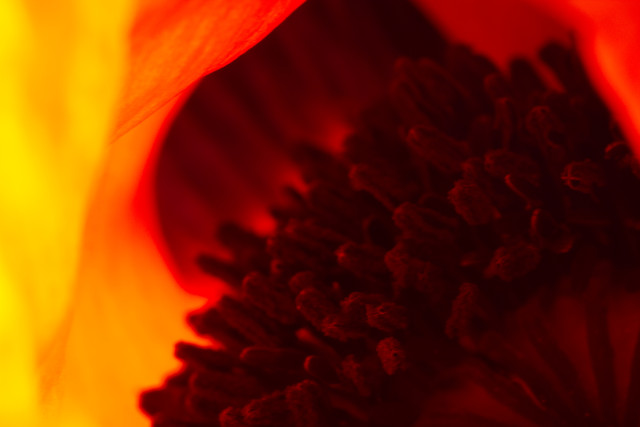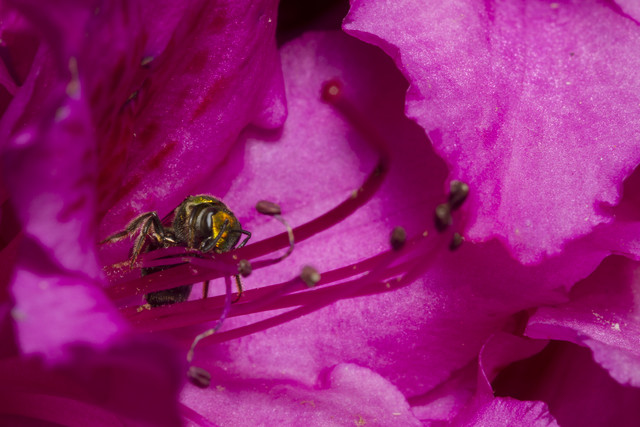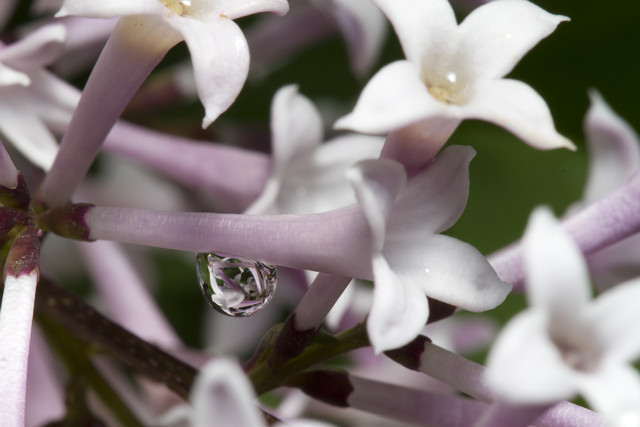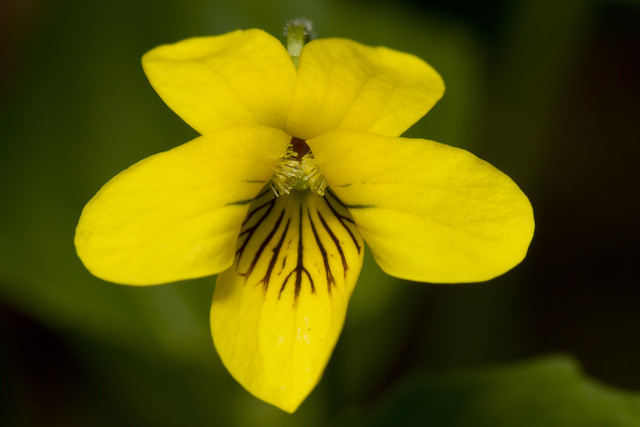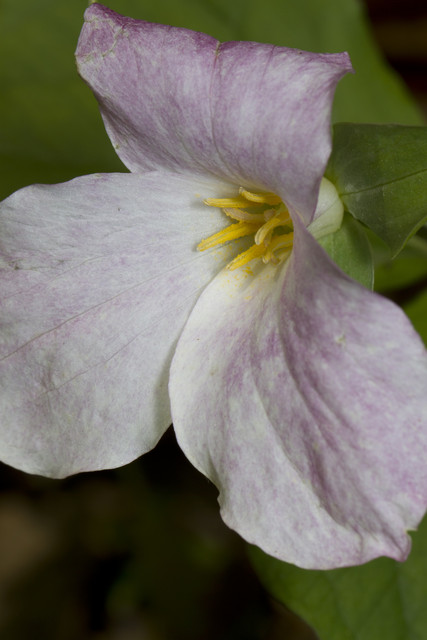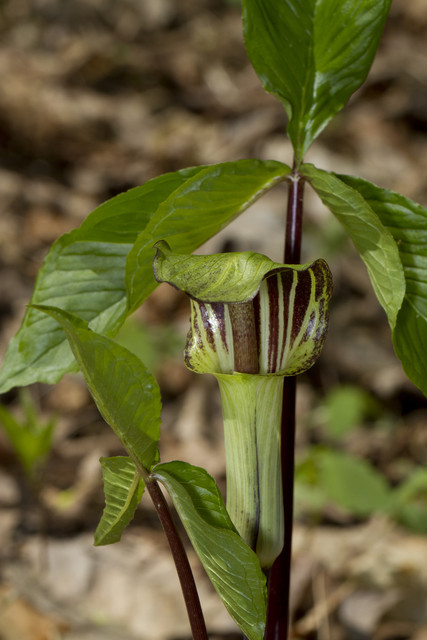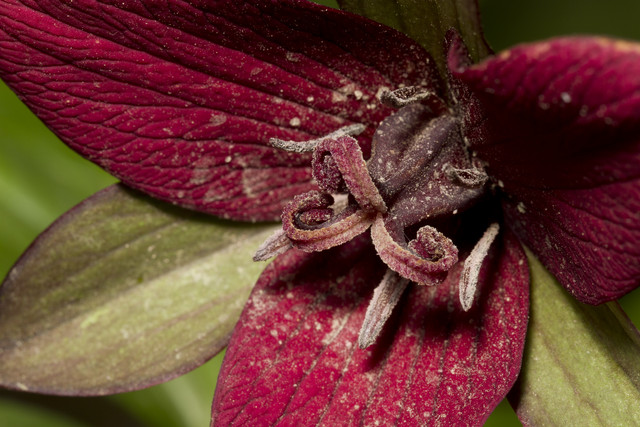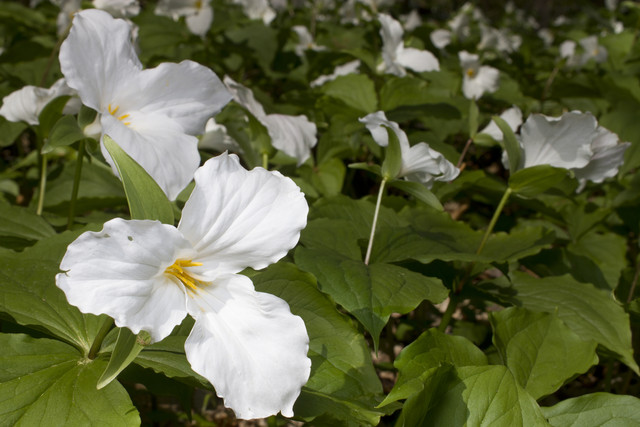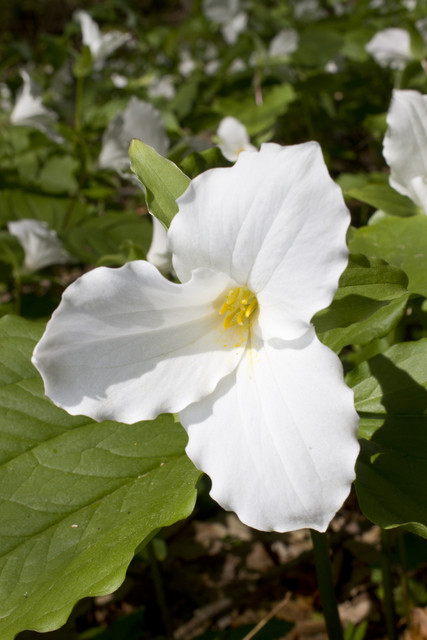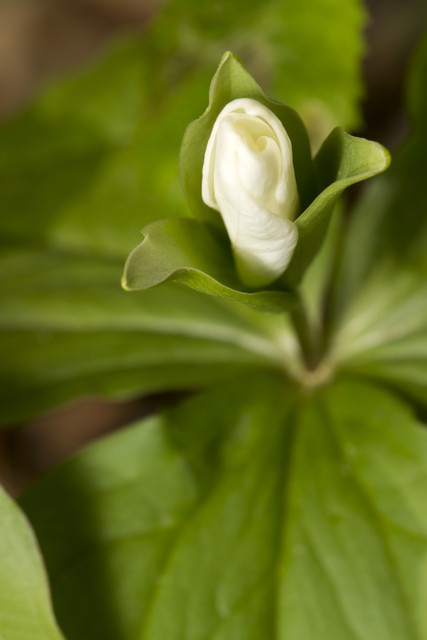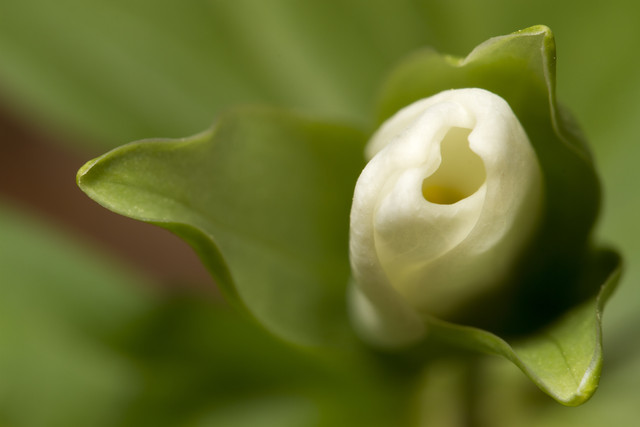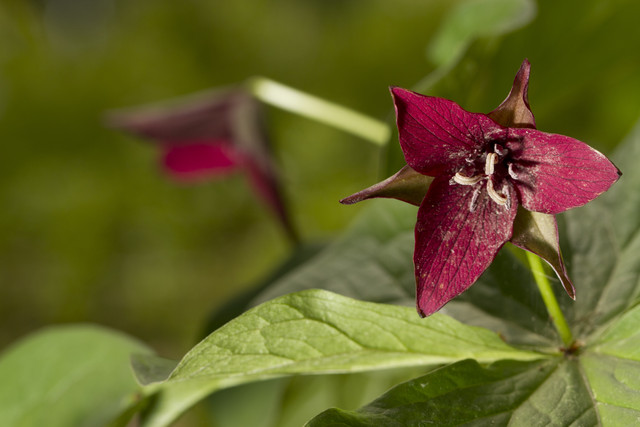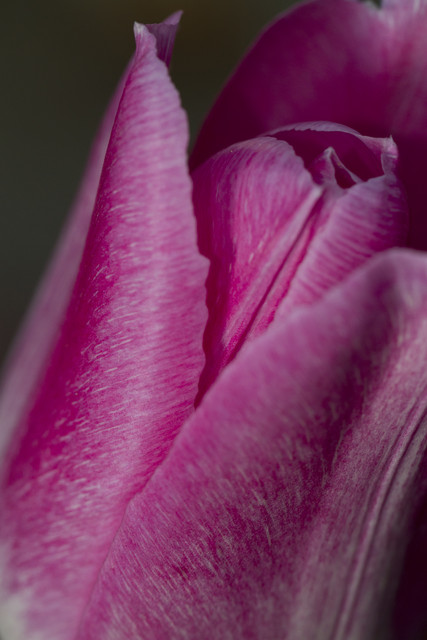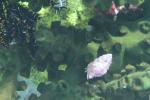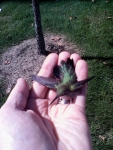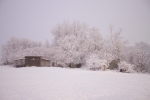flowers
Flashed Poppy
ktuli — Sun, 06/05/2011 - 21:11
 I stopped by my parents' house this afternoon, and had a request for fewer bug shots. I have a stack of bug shots to share, so this will be a quick break (sorry, mom).
I stopped by my parents' house this afternoon, and had a request for fewer bug shots. I have a stack of bug shots to share, so this will be a quick break (sorry, mom).
These shots are of a poppy blossom. Though the perspective and the lighting and the end result are kind of interesting.
First, the view is a macro view down inside the blossom of the pollen stamens. While that isn't necessarily unique, the lighting is kind of interesting. I used my flash to shine up through the petals of the flower to illuminate the shot.
The result is that the light is diffused through the petals and picked up the reddish-orange color. So while the pollen stamens were black, they appear red in the shot.
Technical Data: Canon EOS 7D, Canon EF 100mm f/2.8L Macro IS USM, 1/250 sec at f/16. Canon Speedlight 580EX II flash in auto mode and wireless control. Image Stabilization on. ISO 160. RAW processing in Adobe Camera Raw.
The shots were challenging to get because I hand-held the whole thing. With one hand, I was holding the camera with the 100mm macro (not a light setup) trying to keep it at the minimum focusing distance, and with the other hand I was reaching below the flower to illuminate the shot. I probably should have been using at least one tripod (possibly two) to do all of this, but i simply couldn't be bothered... as usual.
I really like how the shots become an abstract view, and almost have the feel of an electron microscope view.
Technical Data: Canon EOS 7D, Canon EF 100mm f/2.8L Macro IS USM, 1/250 sec at f/16. Canon Speedlight 580EX II flash in auto mode and wireless control. Image Stabilization on. ISO 160. RAW processing in Adobe Camera Raw.
Interesting, no? Drop me a comment and let me know what you think. Sorry - tomorrow, we go back to the bugs.
- Bill
Return of the Crab Spider
ktuli — Thu, 06/02/2011 - 19:54
Yeah - I know... that sounds like a B horror film title, but if you remember - I had a run-in with a crab spider last year too (posts: 1, 2, and 3). Unfortunately, I have some more photos to process tonight, so just sharing one photo, and I'll discuss details on future posts.
Technical Data: Canon EOS 7D, Canon EF 100mm f/2.8L Macro IS USM with Kenko Teleplus PRO 300 "DG" AF 2x Teleconverter, 1/250 sec at f/16. Canon Speedlight 580EX II flash in auto mode and wireless control. Image Stabilization on. ISO 160. RAW processing in Adobe Camera Raw.
I have some really fun stuff to share... soon.
- Bill
Pink Dogwood Blossoms
ktuli — Fri, 05/27/2011 - 18:08
Ok - as promised, here is the calm flower photo to make up for yesterday's spider shots...
Technical Data: Canon EOS 7D, Canon EF 100mm f/2.8L Macro IS USM, 1/250 sec at f/2.8. Canon Speedlight 580EX II flash in auto mode and wireless control. Image Stabilization on. ISO 400. RAW processing in Adobe Camera Raw.
I took several different exposures of this shot, but I really like the almost dreamy feel that this one has because of the extremely wide aperture (f/2.8). Drop me a comment and let me know what you think.
- Bill
Bee on Azalea Flower
ktuli — Tue, 05/24/2011 - 20:29
Technical Data: Canon EOS 7D, Canon EF 100mm f/2.8L Macro IS USM, 1/250 sec at f/16. Canon Speedlight 580EX II flash in auto mode and wireless control. Image Stabilization on. ISO 160. RAW processing in Adobe Camera Raw.
Technical Data: Canon EOS 7D, Canon EF 100mm f/2.8L Macro IS USM, 1/250 sec at f/16. Canon Speedlight 580EX II flash in auto mode and wireless control. Image Stabilization on. ISO 160. RAW processing in Adobe Camera Raw.
Droplet of French Lilacs
ktuli — Tue, 05/24/2011 - 20:12
The same day I found the day lily leaf with water droplets, I found this droplet hanging from one of the french lilacs.
Technical Data: Canon EOS 7D, Canon EF 100mm f/2.8L Macro IS USM, 1/200 sec at f/16. Canon Speedlight 580EX II flash in auto mode and wireless control. Image Stabilization on. ISO 160. RAW processing in Adobe Camera Raw.
I really like how the droplet of water seems to have an alternate world of french lilacs trapped inside. The scene is jam packed with those small lilacs and it still feels like if that drop were to pop that a million more would spill out.
- Bill
Trillium Trails: Assortment
ktuli — Fri, 05/06/2011 - 20:51
Ok - time to just share an assortment... enjoy.
I probably have one or two more shots to share from this set, but I may take a little break to share some other stuff. Either way, stay tuned.
- Bill
Trillium Trails: Sea of Trilliums
ktuli — Wed, 05/04/2011 - 19:04
Sorry, I think I promised I would share this yesterday, but I guess I was just too excited to share that tiny velvet mite that I forgot. I guess to make up for the bait-and-switch and since it seems to be a theme, I'll just share a pair of photos today with not too much blabbering.
Technical Data: Canon EOS 7D, Tokina AT-X M35 Pro DX AF 35mm f/2.8 Macro 1:1, 1/250 sec at f/16. Canon Speedlight 580EX II flash in auto mode and wireless control. Image Stabilization on. ISO 200. RAW processing and cropped in Adobe Camera Raw. Trillium Trails, Fox Chapel, PA.
Technical Data: Canon EOS 7D, Tokina AT-X M35 Pro DX AF 35mm f/2.8 Macro 1:1, 1/250 sec at f/16. Canon Speedlight 580EX II flash in auto mode and wireless control. Image Stabilization on. ISO 200. RAW processing and cropped in Adobe Camera Raw. Trillium Trails, Fox Chapel, PA.
I really wanted to capture the look of a field of the trilliums, but was hitting several problems. First, there were very few areas without large distractions like downed trees or uneven flower coverage or uneven lighting. Then when I did manage to find a fairly decent area of flowers, the shots just looked drab and boring. So I flipped to my Tokina 35mm macro lens and captured the shots you see above. Bringing one of the trilliums large in the foreground with the wide view of the 35mm lens allowing for a nice background showing just how many were around.
Drop me a line and let me know what you think.
- Bill
Trillium Trails: White Trillium Bud
ktuli — Mon, 05/02/2011 - 20:14
When we visited the park the other day, almost every trillium in the area was fully bloomed, so when we spotted this bud, it made for a nice alternative to the rest of the shots I was getting. I (intelligently) shot both horizontal and vertical views of the bud, so we'll review both of them today.
We'll start with the vertical shot. Here I wanted to use the larger leaves to provide a nice background, but to still maintain some definition of their patterns, particularly on the one at the bottom of the frame.
Technical Data: Canon EOS 7D, Canon EF 100mm f/2.8L Macro IS USM, 1/250 sec at f/11. Canon Speedlight 580EX II flash in auto mode and wireless control. Image Stabilization on. ISO 200. RAW processing and cropped in Adobe Camera Raw. Trillium Trails, Fox Chapel, PA.
Why This Photo: Given a partially open bud in seas of trilliums in full bloom (tune in tomorrow for more on that), I simply couldn't pass up the opportunity. The initial shape of the bud with the petals wound together in a rather tall vertical bud to me warranted the vertical format.
What Works: The exposure is well balanced - keeping detail even in the white petals of the bud, and the focus is sharp at the closest edges of the flower and surrounding leaves. The depth of field with an aperture of f/11 is just barely enough to keep the bud in clarity, but blurs everything else softly - though maintaining enough clarity to show the vein pattern in the front leaf.
What Doesn't Work: The brown ground showing between the leaves is somewhat distracting, but not nearly as bad as the stray leaf from a neighboring plant in the bottom left corner. The bruise on the leaf to the upper left is a little distracting as well, and a slightly different angle may have hid that behind the flower. If that had been properly hidden, more depth of field might have worked better to show the leaf patterns better.
Before we move on to the horizontal photo, there are a couple items I want to point out.
First, when people see a trillium for the first time, they often assume that the name comes from the three petals to the flower. Which is partially correct, but if you notice, everything on this plant is in sets of threes. Often times the petals of the flowers are so spectacular that they over shadow the fact that the leaves enclosing the bud until it blooms are in a set of three, as are the leaves further down the stem. It is this repeated sets of three pattern that gives the plant its name, and I feel these shots with the flower still closed help to illustrate that a little better.
Another item of note between these two photos is how focal distance - the distance from the camera to the subject - affects depth of field. All other factors being equal, the further you are from a subject, the greater your depth of field. In these examples, the vertical shot has a focal distance of 0.39 meters, whereas the horizontal is only 0.30 meters - a difference of only 0.09 meters or just over 3.5 inches. However, where the vertical shot is able to keep the entire flower bud in clarity, the horizontal shot is barely able to show half of the bud before the depth of field causes it to blur. In all fairness though, there is one other factor at work here, and that is a slightly different angle. The vertical shot uses a more glancing angle to keep more of the bud in the crisp depth of field, whereas the horizontal shot exaggerates the depth of field by being shot straight on. Still interesting to see how a slight reposition of the camera can have such a dramatic effect with the exact same settings.
Anyway... on to the horizontal shot.
Technical Data: Canon EOS 7D, Canon EF 100mm f/2.8L Macro IS USM, 1/250 sec at f/11. Canon Speedlight 580EX II flash in auto mode and wireless control. Image Stabilization on. ISO 200. RAW processing and cropped in Adobe Camera Raw. Trillium Trails, Fox Chapel, PA.
Why This Photo: After shooting the bud in the vertical format, I felt I still wanted to work with this subject a bit more, and thought I would try a horizontal. To eliminate some of the distractions that the same positioning as the vertical would have provided, I moved in closer and took a more intimate view of the bud.
What Works: Again, the focus is sharp right on the closest edges of the bud and leaves, and this time the closer perspective and straight angle reduces the depth of field down to its shortest amount for this aperture setting. Doing so reduces distractions and places all of the viewers attention right on the point of focus. The one leaf opening slightly more than the others perfectly lent itself to the off-set positioning, and this time, the brown ground showing through the further leaves helps to delineate things and avoid everything blurring together. Top it all off with the slight yellow glow of the pollen inside the bud.
What Doesn't Work: Honestly, I feel hard pressed to find anything wrong with this shot. The simplicity of the macro shot helps to reduce distracting issues. Perhaps the two yellowish bands directly below the bud are distracting, but that's really nit-picking.
I don't know, maybe I'm being a little over-protective of my own image, or I'm just missing the problems with it. Please, if you spot anything you don't like about it, drop me a comment and let me know. I'm always open to constructive criticism.
With how fleeting spring wild flowers are, it will probably be next year before I could even attempt to reshoot this, which adds to the challenge. Capturing this atypical view of such an iconic Pennsylvania flower gives a fresh look at something that quite often gets overlooked by many despite its absolute stunning beauty.
Be sure to stop back tomorrow as I will be sharing shots from this little outing all week (as long as I can keep myself motivated to type up the posts each night!). Thanks for dropping in, and feel free to leave a comment with your thoughts or critiques.
- Bill
Trillium Trails: Red Trillium (part 1)
ktuli — Mon, 05/02/2011 - 07:15
Ok - sorry, can't give this photo a full critique (took me a little too long to process the bunch last night, so just doing a quick post this morning).
For those that were on the trip, hopefully you found these (or other) red trillium (at least I think they are reds, I'll have to do a detailed species check later). We found them at the far end of the one trail, and by the time we made it back to the parking area, everyone had gone, so we couldn't share our find.
Technical Data: Canon EOS 7D, Canon EF 100mm f/2.8L Macro IS USM, 1/250 sec at f/8. Canon Speedlight 580EX II flash in auto mode and wireless control. Image Stabilization on. ISO 200. RAW processing and cropped in Adobe Camera Raw. Trillium Trails, Fox Chapel, PA.
Stop back tomorrow as I'll try getting to a more structured post.
- Bill
Pink Tulip Close-Up
ktuli — Thu, 04/28/2011 - 21:46
Sorry, don't feel much like typing tonight, so just going to share another macro photo with flash... unfortunately, there aren't many bugs out yet, so we're still working on the flowers.
Technical Data: Canon EOS 7D, Canon EF 100mm f/2.8L Macro IS USM, 1/250 sec at f/5. Canon Speedlight 580EX II flash in auto mode and wireless control. Image Stabilization on. ISO 400. RAW processing in Adobe Camera Raw.
This weekend I am heading out to hopefully get some shots of trillium. But secretly I'm hoping to find some bugs too!
Stay tuned.
- Bill

